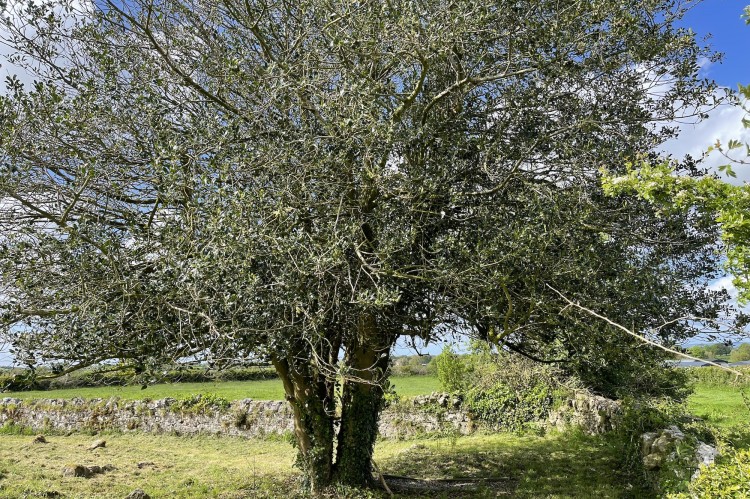Aug
02
2023
This graveyard is in the townland of Killeenoghty, in the parish of Manister and in the barony of Pubblebrien. The townland lies north-east of the village of Croom and the N20, (Cork to Limerick main route.) Lough Nagirra is located south-east of the site and the townlands of Coologe and Toryhill adjoin this townland to the south.
The graveyard can be approached by heading north-east from Croom on the L1408, then take the 4th turn off to the right and then the next right. At the end of this narrow lane, the graveyard is approached by crossing a field to the south-east. The site is only accessible through these lands belonging to the Skelly family.
Killeenoghty translates in Irish to Cill Fhionnachta, meaning the church of Fionnachta, Fionnachta being a saint’s name (Logainm.ie). Cealltar is an Irish name for a graveyard or burial place and this graveyard has Cealltar as part of its name. Killeenoghty was described in 1840 in the Ordnance Survey Letters as ‘Teampal Na Sgeach’, a local name signifying ‘The Church of the Whitethorn Bushes’. Today the site is similarly known as ‘Tempull Na Sceac’ or ‘The Church of the Bushes’.
Killeenoghty Cealltar graveyard is located within an ecclesiastical enclosure.The enclosure is oval in shape and measures 154m NNE x 100m E-W. It is a well preserved earthen bank and there are possible traces in parts of an inner enclosure.
The graveyard is rectangular in shape, measuring 33m N-S x 49m E-W, and is enclosed by a substantial post-1700 stone wall, located in the southern half of the enclosure. The entrance gate to the graveyard is in the west wall. According to the Ordnance Survey Letters (1840) only the outline of the medieval church’s foundations were present, roughly in the centre of the graveyard. Today little of them can be seen, though aerial photographs have picked up the outline of the church’s ruins.
A total of 47 memorials were recorded during the Historic Graves survey.
The oldest memorial records the burial place of Joan Regan (nee Moloney) who died in 1795, (memorial no. 037). Hannah Carmody who died in 1798, and her husband Bartholemew Quilty who died in 1799,(memorial no.012) are the next two earliest.
Very early 19th century burials included Maurice Irwin who died in 1805 aged 21, (memorial no. 024). John Quilty died in 1806, (memorial no. 007), and a son and a daughter of the Ward family who died in 1807, (memorial no. 020).
Very well preserved carved detail is found on the headstones of the early 19th century. Detailed sunbursts and foliage can clearly be seen. On the memorial to Bartholemew Quilty, who died in 1817, (memorial no.006), Grady, the memorial sculptor's name is clearly legible. Memorials to William Ward (1808), (memorial no.019) and John Quilty (1806), (memorial no.007) were carved by Richard Garvey.
The following surnames were some of the names recorded; Quirke, Carmody, Farrell, Moloney, Ryan, Toomey, Regan, Finn, Ward, Casey, Farrell, Butler, O’Brien, Power, Morrisy, Quilty, Nunan and Malone.
Interesting Facts
Westropp (1904-5) relates an interesting story about the origins of the name of Killeenoghty Church and graveyard. He says that the church was called Cill Fhionshneachta, meaning the church of the wine red snow. According to the legend a saint was killed at the door of the church when the ground was covered in snow. The blood of the saint coloured the snow wine-red. (Diocesan Heritage Project, Manister).
18th Century Memorials in Killeenoghty Graveyard
012 Hannah Carmody 1798 and Bartholemew Quilty 1799
037 Joan Regan (nee Moloney) 1795
Notes
Grass covered vault, 12 burials ??
Possible childrens burial plot associated with Croom Hospital
The Diocesan Heritage Project (Manister Parish) mentions that Famine victims were buried here too
This post was researched and written as part of a grassroots heritage tourism project (www.incultum.eu) in collaboration with Ballyhoura Development CLG (https://www.ballyhouradevelopment.com/), Cork Co. Council (https://www.corkcoco.ie/en) and Limerick Co. Council (https://www.limerick.ie/council). The stories were initially gathered during a community survey of the graveyard. They form part of the Historic Graves Project Destination for Ballyhoura (https://historicgraves.com/destination/ballyhoura).



